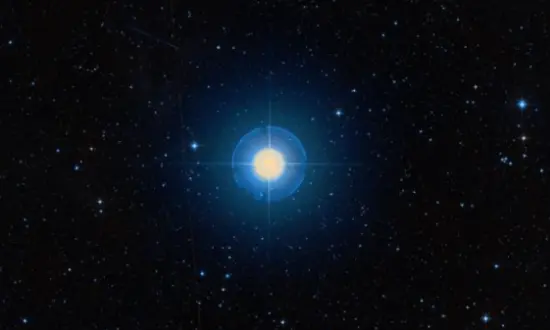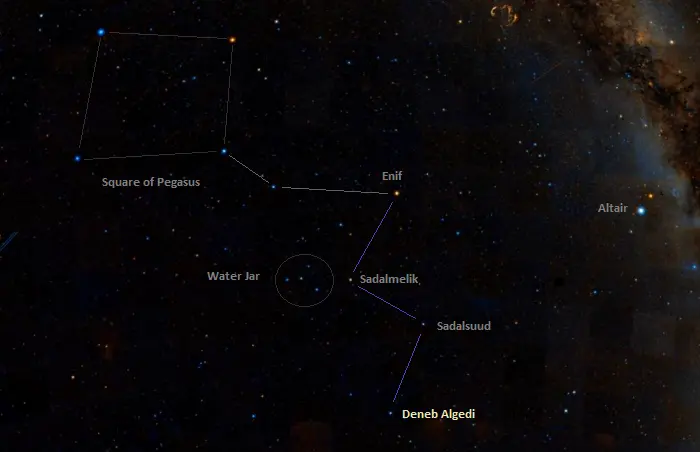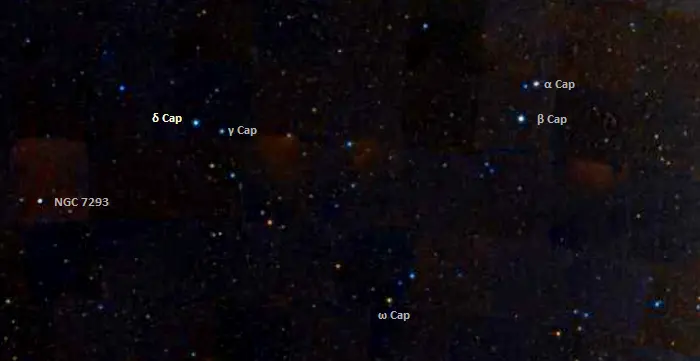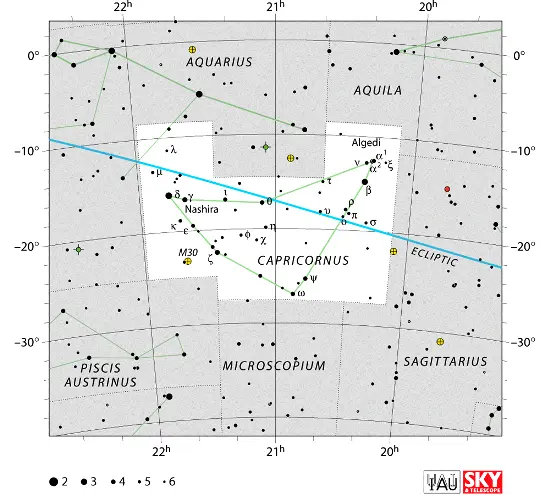Deneb Algedi, Delta Capricorni (δ Cap), is the primary component in a multiple star system located 38.70 light-years away in the constellation Capricornus. With a combined apparent magnitude of 2.81, it is the brightest point of light in Capricornus. The giant star is part of an Algol-type eclipsing binary system.
Star system
Delta Capricorni is a multiple star system consisting of four components, the eclipsing binary star Delta Capricorni A and the companions Delta Capricorni B and C.
Delta Capricorni A has the spectral type kA5hF0mF2III, indicating a chemically peculiar giant star with the calcium K-line that matches the temperature of a blue-white A5-type star, the hydrogen emission of an F0-type star, and the metallic absorption lines of an F2 star. The exact classification has been made challenging by the light pollution of the companion. At different times, the primary component was classified as a main sequence star, a subgiant, and a giant.

Deneb Algedi (Delta Capricorni), image: Wikisky
The primary component, Delta Capricorni Aa, is a giant star that has stopped fusing hydrogen into helium at its core and evolved away from the main sequence. The chemical peculiarity in its spectrum may be caused by some elements being pushed toward the surface while others drift downward, or by contamination from the fainter companion.
Delta Capricorni Aa, formally known as Deneb Algedi, has a mass of 2 solar masses and a radius of 1.91 solar radii. With a surface temperature of 7,301 K, it shines with 8.5 solar luminosities.
With only twice the Sun’s mass, the star is not massive enough to go out as a supernova when it reaches the end of its life cycle. Instead, it will shed its outer envelope to form a planetary nebula and slowly fade away as a dim white dwarf.
Delta Capricorni is a metallic-line star (Am star), an A-type chemically peculiar Am star with strong and usually variable absorption lines of some metals like zinc, zirconium, barium, and strontium, and deficiencies of calcium or scandium. The best-known Am stars in the sky are Sirius, Castor Ba, Acubens, Kurhah, and IK Pegasi, the nearest supernova candidate to the Sun.
Deneb Algedi is a fast spinner, with a projected rotational velocity of 105 km/s. The high spin rate is synchronous with the orbital period but unusual for an Am star. Am stars are usually found in binary systems in which the rotation of both components has been slowed by tidal braking.
Delta Capricorni Aa and Delta Capricorni Ab form an Algol-type eclipsing binary system. They have an orbital period of 1.022768 days and an inclination close to our line of sight. The assumed orbit eccentricity is 0.
The two components eclipse each other during their orbit, causing the star system’s overall brightness to periodically drop. The system has a peak apparent visual magnitude of 2.81 and is at its faintest when the secondary star eclipses the primary. During an eclipse of the primary, the apparent magnitude of the star system decreases by 0.24 magnitudes. When the primary star eclipses the secondary, the system’s brightness drops by 0.09 magnitudes.
The component Delta Capricorni Ab was once suspected to be a white dwarf but is now believed to be a class G or K main sequence star or a star in the pre-main sequence stage.
The Delta Capricorni star system has two visual companions, a 15th magnitude star at a separation of one arcminute and a 13th magnitude star more than 2 arcminutes away.
Facts
Deneb Algedi lies only 2.6 degrees south of the ecliptic, in the path of the Moon and planets. It can be occulted by the Moon and, less frequently, by planets. In the past century, lunar occultations were observed in 1951, 1962, and 1988.
Delta Capricorni A was discovered to be a spectroscopic binary by the American astronomer Vesto Slipher in 1906. Slipher analyzed the radial velocity of the Delta Capricorni system at Lowell Observatory in Flagstaff, Arizona, and reported that it is variable. He concluded that Delta Capricorni is a spectroscopic binary star with a short period.
In 1921, Clifford Crump measured the system’s radial velocity at Yerkes Observatory in Williams Bay, Wisconsin, and determined its orbital elements. Based on observations made between June 1915 and August 1919, he found a period of 1.02275 days.
The Delta Capricorni A system was discovered to be an eclipsing binary star by the American astronomer Olin J. Eggen in 1956. Eggen observed the system with a 12-inch refractor with a 1P21 photomultiplier and a yellow filter at the Lick Observatory on Mount Hamilton, California, on July 1 and 2, 1956. He used Nashira (Gamma Capricorni) as the comparison star.
Delta Capricorni was once suspected to be a Delta Scuti variable, a young pulsating star whose pulsation period corresponds to the variations in its luminosity. Delta Scuti stars are used as standard candles for establishing distances to deep sky objects such as galaxies, open clusters, and globular clusters. However, a 1994 study found no evidence to support the short-period variation typical of Delta Scuti variables. The authors did bring up the possibility that mild chromospheric activity of the cooler companion, which is about 3 magnitudes fainter, may contribute to the scatter in the broadband photometry. The coronal activity of the companion has also been linked with extreme ultraviolet and radio emissions.
The position of Delta Capricorni in the sky roughly corresponds to the position of Neptune when the planet was discovered. Neptune was found by the German astronomer Johann Galle on September 23, 1846. It was five degrees east of Deneb Algedi, just northeast of the fainter Iota Aquarii.
In medieval astrology, Deneb Algedi was one of the 15 Behenian fixed stars, which were used in astrology readings. These stars were believed to be a source of astrological power for one or more planets, and each was linked with a gemstone and plant. In medieval times, these gemstones and plants were used in magic rituals. Deneb Algedi was connected with chalcedony gemstone and marjoram plant, and associated with the planets Saturn, Jupiter, and Mercury. If culminating, it was said to bring fame, wealth, great glory, authority, and dignity.
Name
The name Deneb Algedi (pronunciation: /ˌdɛnɛb ælˈdʒiːdiː/) comes from the Arabic phrase ðanab al-jady, meaning “the tail of the goat.” It refers to the star’s position in the constellation Capricornus (the Sea Goat). Capricornus was historically depicted as a sea goat with a fishlike tail.
The name Deneb Algedi was approved by the International Astronomical Union’s (IAU) Working Group on Star Names (WGSN) on February 1, 2017. It formally applies only to the primary component, Delta Capricorni Aa, but has traditionally been used for the entire star system.
The star was historically also known by its alternative name, Scheddi. Deneb Algedi is the transcription of the star’s name as it appeared in the 15th-century Persian astronomer Ulugh Beg’s star catalogue.
Deneb Algedi is not the only Deneb in the sky. Other bright “tail” stars include Deneb in the constellation Cygnus (the Swan), Denebola in Leo (the Lion), and Aldhanab in Grus (the Crane), which once represented the tail of the Southern Fish (Piscis Austrinus). Diphda, a giant star in the tail of Cetus, was historically known as Deneb Kaitos, and Epsilon and Zeta Aquilae in the tail of the Eagle were both known as Deneb el Okab.
Deneb Algedi is one of the several Capricornus stars whose names refer to the celestial goat. Alpha2 Capricorni is formally known as Algedi. Traditionally, the stars Alpha1 and Alpha2 Capricorni were known as Algedi Prima and Algedi Secunda, and Omega Capricorni is informally known as Baten Algedi (“the belly of the goat”).
In Chinese astronomy, Delta Capricorni was known as 壘壁陣四 (Lěi Bì Zhèn sì), the Fourth Star of the Line of Ramparts. The Line of Ramparts is an asterism formed by Kappa Capricorni, Epsilon Capricorni, Nashira (Gamma Capricorni), Deneb Algedi (Delta Capricorni), Iota Aquarii, Ancha (Theta Aquarii), Lambda Aquarii, Phi Aquarii, 27 Piscium, 29 Piscium, 33 Piscium, and 30 Piscium. The asterism was part of the Encampment mansion, one of the northern mansions of the Black Tortoise.
Location
Deneb Algedi is the leftmost star in the faint V-shaped constellation figure of Capricornus. It lies in the northwestern part of the constellation, near the border with Aquarius. It can be found by star-hopping from Markab, the star at the southwestern corner of the Great Square of Pegasus, to Enif, the brightest star in Pegasus.
Enif forms an asterism known as the Lightning Bolt with the supergiants Sadalmelik and Sadalsuud in Aquarius and with Deneb Algedi. Enif is the brightest of the four stars, shining at magnitude 2.4. Sadalmelik is easy to identify because it appears next to the Water Jar of Aquarius, and Sadalsuud, the brightest star in Aquarius, follows the zig-zag pattern to Deneb Algedi.

The location of Deneb Algedi, image: Wikisky
Even though it lies south of the celestial equator, with a declination of -16°, Deneb Algedi is visible from virtually all inhabited locations in the northern hemisphere for at least part of the year. It never rises above the horizon for observers north of the latitude 74° N.

The position of Deneb Algedi in Capricornus, image: Wikisky
Constellation
Deneb Algedi lies in the constellation Capricornus. The celestial Sea Goat is one of the Greek constellations, catalogued by the Greco-Roman astronomer Ptolemy of Alexandria in his Almagest in the 2nd century CE. In Greek mythology, it is associated with Amalthea, the goat that looked after the infant Zeus and hid him from his father Cronus. The constellation is sometimes also linked with Pan, the god of the wild, who had a goat’s legs, hindquarters, and horns. In mythology, Pan fled from the monster Typhon after giving himself a fish’s tail and jumping into a river.
Capricornus is the smallest and one of the faintest zodiac constellations, with only one star – Deneb Algedi – brighter than magnitude 3.0.
Other notable stars in Capricornus include the yellow-white giant Algedi (Alpha2 Capricorni), the yellow supergiant Alpha1 Capricorni, the multiple star system Beta Capricorni (Dabih), the hot blue star Alshat (Nu Capricorni), and the giants Nashira (Gamma Capricorni) and Omega Capricorni.

Capricornus constellation map by IAU and Sky&Telescope magazine
Deep sky objects in the constellation include the bright globular cluster Messier 30, the fainter globular Palomar 12, the compact galaxy group HCG 87, the spiral galaxy IC 1337, and the interacting lenticular galaxies NGC 7035 and NGC 7035A.
The best time of the year to see the stars and deep sky objects in Capricornus is during the month of September, when the constellation is high above the horizon in the evening. The entire constellation is visible from locations south of the latitude 60° N.
The 10 brightest stars in Capricornus are Deneb Algedi (Delta Cap, mag. 2.81), Dabih (Beta Cap, mag. 3.05), Algedi (Alpha2 Cap, mag. 3.57), Nashira (Gamma Cap, mag. 3.67), Zeta Capricorni (mag. 3.77), Theta Capricorni (mag. 4.07), Omega Capricorni (mag. 4.11), Psi Capricorni (mag. 4.13), Iota Capricorni (mag. 4.296), and Alpha1 Capricorni (mag. 4.27).
Deneb Algedi – Delta Capricorni
| Spectral class | kA5hF0mF2III |
| Variable type | Algol-type eclipsing binary |
| U-B colour index | +0.07 |
| B-V colour index | +0.31 |
| Apparent magnitude | 2.81 (2.81 – 3.05) |
| Absolute magnitude | 2.48 |
| Distance | 38.70 ± 0.09 light-years (11.87 ± 0.03 parsecs) |
| Parallax | 85.9406 ± 0.3327 mas |
| Radial velocity | -3.40 ± 0.8 km/s |
| Proper motion | RA: +259.707 ± 0.497 mas/yr |
| Dec.: -296.721 ± 0.448 mas/yr | |
| Age | 600 million years |
| Constellation | Capricornus |
| Right ascension | 21h 47m 02.4458212588s |
| Declination | −16° 07′ 38.238324701″ |
| Names and designations | Deneb Algedi, Delta Capricorni, δ Cap, 49 Capricorni, HD 207098, HR 8322, HIP 107556, SAO 164644, FK5 819, BD−16 5943, GJ 837, GC 30491, GCRV 13686, PPM 239339, JP11 3405, LTT 8693, NLTT 52065, IRAS 21442-1621, PLX 5258.00, 2MASS J21470244-1607382, UBV 21648, TYC 6363-1044-1, EUVE J2147-16.1, Gaia DR3 6838311796136238976, ADS 15314 A, WDS 21470-1608A, CCDM J21470-1607A, IDS 21415-1635 A |
Delta Capricorni A
| Mass | 2.0 M☉ |
| Luminosity | 8.5 L☉ |
| Radius | 1.91 R☉ |
| Temperature | 7,301 K |
| Metallicity | -0.13 dex |
| Rotational velocity | 105 km/s |
| Surface gravity | 3.66 cgs |
Delta Capricorni B
| Mass | 0.73 M☉ |
| Radius | 0.9 R☉ |
| Temperature | 4,500 K |